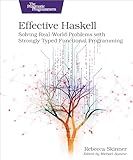Best Graph Traversal Books in Haskell to Buy in January 2026

Learn You a Haskell for Great Good!: A Beginner's Guide
- AFFORDABLE OPTION WITH QUALITY ASSURANCE FOR SAVVY READERS.
- ECO-FRIENDLY CHOICE, PROMOTING SUSTAINABILITY THROUGH REUSE.
- UNIQUE SELECTION: FIND RARE GEMS AND HIDDEN LITERARY TREASURES.



Programming in Haskell



Effective Haskell: Solving Real-World Problems with Strongly Typed Functional Programming



Learn Physics with Functional Programming: A Hands-on Guide to Exploring Physics with Haskell



Real World Haskell
- AFFORDABLE PRICING FOR QUALITY PRE-OWNED READS.
- ECO-FRIENDLY CHOICE: CONTRIBUTE TO SUSTAINABLE READING!
- THOROUGHLY INSPECTED FOR QUALITY AND USABILITY.



Get Programming with Haskell



Learn Haskell by Example (Bookcamp)


In Haskell, there are various ways to traverse a graph, depending on the specific requirements and characteristics of the graph. One common approach is to represent the graph using an adjacency list or an adjacency matrix. Here is an overview of how to traverse a graph in Haskell:
- Representing the graph: Start by representing the graph using appropriate data structures. An adjacency list is a commonly used representation, where each vertex is associated with a list of its adjacent vertices. You can use a dictionary-like data structure (such as Data.Map) to map each vertex to its adjacent vertices, or simply use a list of pairs.
- Depth-first search (DFS): DFS is a widely used graph traversal algorithm. It explores as far as possible along each branch before backtracking. To perform a DFS on the graph, you can use a recursive function. Here's a high-level DFS implementation:
dfs :: (Ord a) => a -> Map a [a] -> [a] dfs start graph = dfsHelper [start] [] where dfsHelper [] visited = visited dfsHelper (v:vs) visited | v `elem` visited = dfsHelper vs visited | otherwise = dfsHelper (adjacentVertices ++ vs) (v:visited) where adjacentVertices = filter (`notElem` visited) (fromMaybe [] $ Map.lookup v graph)
This function takes a starting vertex (start) and an adjacency list (graph). It maintains two lists: visited to keep track of visited vertices, and vs (stack) to store the next vertices to be visited. The function uses pattern matching to handle the base case where the stack is empty and the recursive case where it processes the next vertex.
- Breadth-first search (BFS): BFS is another common graph traversal algorithm that explores all the vertices of a graph in breadth-first order. BFS can be implemented using a queue data structure, where it visits vertices in the order they were discovered. Here's a high-level BFS implementation:
bfs :: (Ord a) => a -> Map a [a] -> [a] bfs start graph = bfsHelper [start] [] where bfsHelper [] visited = visited bfsHelper (v:vs) visited | v `elem` visited = bfsHelper vs visited | otherwise = bfsHelper (vs ++ adjacentVertices) (visited ++ [v]) where adjacentVertices = filter (`notElem` visited) (fromMaybe [] $ Map.lookup v graph)
Similar to DFS, this function takes a starting vertex (start) and an adjacency list (graph). It uses a queue-like structure to store the next vertices to be visited. The algorithm keeps track of visited vertices and continues until all vertices have been visited.
These are just two examples of graph traversal algorithms in Haskell. Depending on your specific requirements or the characteristics of your graph, you can explore other approaches, such as Dijkstra's algorithm or topological sorting.
What is a topological sort in graph traversal using Haskell?
In graph theory, a topological sort is an algorithm for ordering the vertices of a directed acyclic graph (DAG) in such a way that for every directed edge (u, v), vertex u comes before vertex v in the ordering. A topological sort can only be performed on DAGs because cyclic graphs do not have a valid sort order.
In Haskell, a topological sort can be implemented using depth-first search (DFS) and a stack data structure. Here's an example implementation:
import Data.Graph
topologicalSort :: Graph -> [Vertex] topologicalSort g = reverse $ explore [] [] $ vertices g where explore :: [Vertex] -> [Vertex] -> [Vertex] -> [Vertex] explore visited stack [] = visited explore visited stack (v:vs) | v `elem` visited = explore visited stack vs | otherwise = explore (v : visited) (vs' ++ stack) vs where vs' = preorder g v \\ visited
-- Example usage: -- Let's say we have the following graph: -- 0 -> 1 -- | | -- v v -- 2 -> 3 exampleGraph :: Graph exampleGraph = buildG (0, 3) [(0, 1), (2, 3), (0, 2), (1, 3)]
main :: IO () main = print $ topologicalSort exampleGraph
In this implementation, the topologicalSort function takes a graph g and returns a list of vertices sorted in the topological order. The explore helper function performs a DFS starting from a vertex, visiting its adjacent vertices and adding them to the stack. It keeps track of the visited vertices to avoid revisiting them.
The resulting topological sort is derived by reversing the visited vertices list because during DFS, the vertices that finish earlier are pushed onto the stack first.
For the example graph in the main function, the output would be [0, 2, 1, 3], which represents a valid topological sort order for the given DAG.
How to check if a graph is planar using Haskell?
To check if a graph is planar using Haskell, you can use various algorithms and libraries available. Here's an example using the Graphalyze library:
- Start by installing the Graphalyze library by adding it as a dependency in your project's Cabal file: build-depends: graphalyze >= 0.12
- Import the required modules in your Haskell code:
import Math.Graphs hiding (isPlanar) import Math.Graphs.Skeleton import Math.GraphPlanarity import Data.Graph.Inductive.Graph import Data.Set (toList)
- Define a function to check if a graph is planar:
isPlanar :: (DynGraph gr) => gr a b -> Bool isPlanar graph = isPlanarSkeleton (getSkeleton $ undir graph)
- Use the function to check if a graph is planar. Here's an example with a sample graph:
sampleGraph :: Gr () () sampleGraph = mkGraph [(1, ()), (2, ()), (3, ()), (4, ())] [(1, 2, ()), (2, 3, ()), (3, 1, ()), (3, 4, ()), (1, 4, ())]
main :: IO () main = do let planar = isPlanar sampleGraph putStrLn $ "Is the graph planar? " ++ show planar
This code checks if the sampleGraph is planar using the isPlanar function and prints the result.
Note that checking if a graph is planar is a computationally expensive problem, so for large graphs, the execution time may be significant. Additionally, you can explore other planarity algorithms and libraries like Plantri or graph-rewriting to check for planarity.
What is an Eulerian path in graph traversal using Haskell?
In graph theory, an Eulerian path is a path in a graph that visits each edge exactly once.
In Haskell, we can represent a graph using various data structures, such as an adjacency matrix or an adjacency list. Here, we will use an adjacency list representation, where each vertex is associated with a list of its neighboring vertices.
To find an Eulerian path in a graph using Haskell, we can implement the Hierholzer's algorithm, which breaks down the problem into finding a sequence of subpaths that form an Eulerian circuit.
Here is an example implementation of finding an Eulerian path in Haskell:
import Data.List
type Graph = [(Int, [Int])]
-- Finds an Eulerian path in the given graph eulerianPath :: Graph -> [Int] eulerianPath graph = reverse $ findPath graph []
-- Internal recursive function to find the Eulerian path findPath :: Graph -> [Int] -> [Int] findPath [] path = path findPath ((v, edges):graph) path | length edges == 0 = findPath graph (v:path) | otherwise = findPath ((v, tail edges):graph) (head edges:path)
-- Generates the adjacency list representation of a graph -- Here, we assume the input is a list of edges [(v1, v2)] generateGraph :: [(Int, Int)] -> Graph generateGraph edges = map (\v -> (v, map snd $ filter (\(x, y) -> x == v) edges)) vertices where vertices = nub $ concatMap (\(x, y) -> [x, y]) edges
-- Example usage: main :: IO () main = do let edges = [(1, 2), (2, 3), (3, 1), (2, 4), (4, 1)] let graph = generateGraph edges let path = eulerianPath graph putStrLn $ "Eulerian Path: " ++ intercalate "->" (map show path)
In this example, we define a type alias Graph for the adjacency list representation. The eulerianPath function takes a graph as input and returns the Eulerian path as a list of vertices. The generateGraph function generates the adjacency list representation based on the list of edges.
In the main function, we define an example graph with five vertices and five edges. We generate the corresponding adjacency list representation using generateGraph. Finally, we find the Eulerian path using eulerianPath and print it out.
What is a Hamiltonian path in graph traversal using Haskell?
A Hamiltonian path in graph theory is a path in a graph that visits every vertex exactly once. In the context of graph traversal in Haskell, a Hamiltonian path can be represented as a list of vertices that form a valid path.
Here is an example implementation of a function to find a Hamiltonian path in a given graph using Haskell:
import Data.List (permutations)
type Vertex = Int type Graph = [(Vertex, [Vertex])]
hamiltonianPaths :: Graph -> [[Vertex]] hamiltonianPaths graph = filter isHamiltonian allPaths where isHamiltonian path = all (`elem` path) vertices && all distinctPairs (zip path (tail path)) allPaths = permutations vertices vertices = map fst graph distinctPairs (x, y) = x /= y
-- Example usage: -- let graph = [(1, [3, 4]), (2, [3, 4, 5]), (3, [1, 2, 4]), (4, [1, 2, 3]), (5, [2])] -- hamiltonianPaths graph should return [[1,3,2,4,5], [2,3,1,4,5], [1,4,2,3,5], [2,4,3,1,5]]
In this example, the Graph type synonym defines a graph as a list of vertices paired with their adjacent vertices. The hamiltonianPaths function takes a graph as input and generates all possible permutations of the vertices. Each permutation is checked for being a valid Hamiltonian path by ensuring that all vertices are present in the path and that all pairs of adjacent vertices are distinct. The function returns a list of all valid Hamiltonian paths found.
